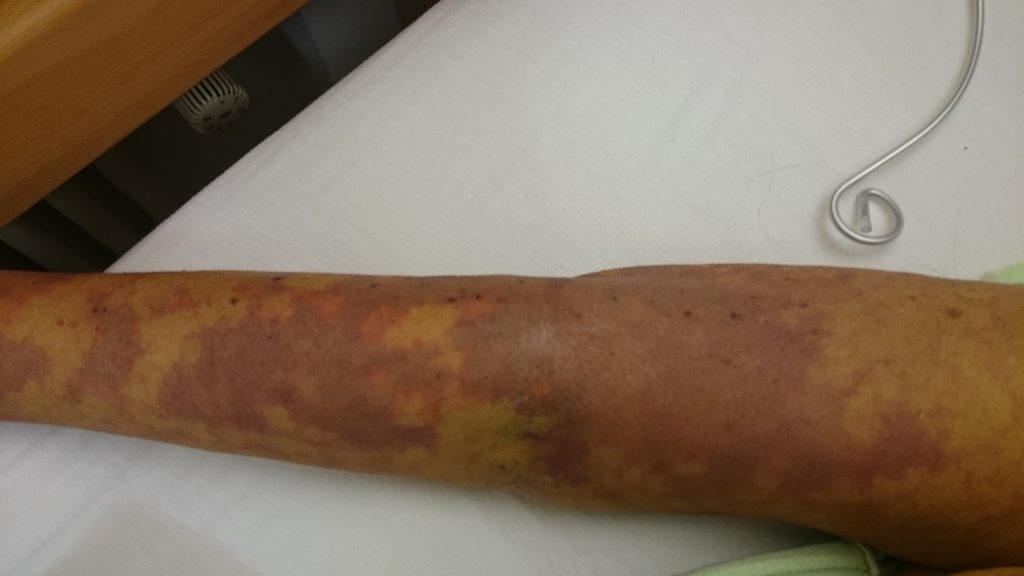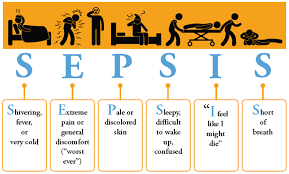Sepsis is a serious condition in which the body responds improperly to an infection. The infection-fighting processes turn on the body, causing the organs to work poorly.
OVERVIEW
Sepsis may progress to septic shock. This is a dramatic drop in blood pressure that can damage the lungs, kidneys, liver and other organs. When the damage is severe, it can lead to death. Early treatment of sepsis improves chances for survival. There are approximately 1.7 million cases of sepsis each year, according to the Centers for Disease Control and Prevention (CDC)Trusted Source. In addition, this type of infection kills nearly 270,000 people in the United States every year.
Keep reading to learn more about sepsis symptoms, treatment, and complications.
WHAT IS SEPSIS?

Sepsis is a life threatening illness caused by your body’s response to an infection. Your immune system protects you from many illnesses and infections, but it’s also possible for it to go into overdrive in response to an infection.
WHAT ARE THE STAGES OF SEPSIS?
There are three stages of sepsis:
- Sepsis. An infection gets into your bloodstream and causes inflammation in your body.
- Severe sepsis. The infection and inflammation is severe enough to start affecting organ function.
- Septic shock. Septic shock is a severe complication of sepsis that causes a significant drop in blood pressure. This can lead to many serious complications including:
- organ dysfunction
- respiratory or heart failure
- stroke
- possible death
In some cases, you might not even know you have an infection that could potentially lead to sepsis.
WHAT ARE THE CAUSES OF SEPSIS?
Any infection can trigger sepsis, but the following types of infections have a higher risk of causing sepsis:
- pneumonia
- abdominal infections
- kidney infections
- blood poisoning
- Catheter sites.
- Wounds or burns.
WHAT ARE THE SYMPTOMS OF SEPSIS?

Symptoms of sepsis may include:
- Change in mental status.
- Fast, shallow breathing.
- Sweating for no clear reason.
- Feeling lightheaded.
- Shivering.
- Symptoms specific to the type of infection, such as painful urination from a urinary tract infection or worsening cough from pneumonia.
What are the signs and symptoms of severe sepsis?
Severe sepsis is characterized by organ failure. You must have one or more of the following signs to be diagnosed with severe sepsis:
- difficulty breathing
- bluish discoloration of the skin, especially lips, fingers, toes
- chills due to a drop in body temperature
- decreased urination
- dizziness
- changes in mental ability
- extreme weakness (asthenia)
- low platelet count (thrombocytopenia)
- abnormal heart functions
- unconsciousness
What are the signs and symptoms of septic shock (septicemia)?
Sepsis can advance very quickly to severe sepsis and septic shock. As it transitions, it becomes more life threatening.
Some severe sepsis and septic shock symptoms can overlap, like severe difficulty breathing, acute confusion, and bluish skin. Another key symptom of septic shock is very low blood pressure.
WHO IS AT RISK FOR SEPSIS?
Some factors that increase the risk infection will lead to sepsis include:
- People over age 65.
- Infancy.
- People with lower immune response, such as those being treated for cancer or people with HIV.
- People with chronic diseases, such as diabetes, kidney disease or COPD.
- Admission to intensive care unit or longer hospital stays.
- Devices that go in the body, such as catheters in the vein, called intravenous, or breathing tubes.
- Treatment with antibiotics in the last 90 days.
- A condition that requires treatment with corticosteroids, which can lower immune response.
WHAT ARE THE LONG-TERM COMPLICATIONS OF SEPSIS?
With prompt treatment, many people with sepsis recover completely and return to leading normal lives. But others may experience long-term effects. You may develop complications such as:
- Insomnia.
- Nightmares or hallucinations.
- Panic attacks.
- Joint and muscle pain.
- Decreased cognitive functioning (learning, remembering, concentrating and making decisions).
- Organ failure.
You’re also at a higher risk of developing sepsis again. So, make sure to have any new infections treated immediately.
HOW DO WE DIAGNOSE SEPSIS IN OUR FACILITY?
If you have sepsis symptoms, we will order tests to diagnose and determine the severity of your infection. One of the first tests is a blood test. Your blood is checked for complications like:
- infection
- clotting problems
- abnormal liver or kidney function
- decreased amount of oxygen
- an electrolyte imbalance, which affects the amount of water in your body and the acidity of your blood
Depending on your symptoms and the results of your blood test, we may order other tests, including:
- a urine test (to check for bacteria in your urine)
- a wound secretion test (to check an open wound for an infection)
- a mucus secretion test (to identify germs responsible for an infection)
If we can’t determine the source of an infection using the above tests, they may order an internal view of your body using one of the following:
- chest x-rays to view the lungs
- CT scans to view possible infections in the appendix, pancreas, or bowel area
- ultrasounds to view infections in the gallbladder or ovaries
- MRI scans, which can identify soft tissue infection
MANAGEMENT AND TREATMENT
How do we manage sepsis in our facility?
Sepsis treatment needs to begin immediately. The most important concern in sepsis protocol is a quick diagnosis and prompt treatment.
If we diagnose patient with sepsis, we usually place them in the intensive care unit (ICU) of the hospital for special treatment. You may receive the following treatment for sepsis:
- Antibiotics: You’ll receive antibiotics if you have a bacterial infection.
- IV (intravenous) fluids: You’ll need fluids to maintain blood flow to your organs and prevent your blood pressure from dropping too low.
- Vasopressor medications: Vasopressors tighten blood vessels. In some cases, you may need them to reach an adequate blood pressure.
- Appropriate supportive care: If organ failures occur, you’ll need other sepsis treatments such as dialysis for kidney failure or mechanical ventilation for respiratory failure.
- Surgery: You may need surgery to remove damaged tissue.
PREVENTION
How can you help prevent sepsis?
Steps you can take to prevent sepsis include:
- Practicing good hygiene, including handwashing.
- Keeping cuts and other wounds clean, and keeping them covered until healed.
- Keeping up to date on recommended vaccines.
- Getting routine medical care for chronic conditions.
- Getting medical attention immediately if you suspect an infection.
What is the outlook (prognosis) for sepsis?
With quick diagnosis and treatment, many people with mild sepsis survive. Without treatment, most people with more serious stages of sepsis will die. Even with treatment, 30% to 40% of people with septic shock, the most severe stage of sepsis, will die.

Recent Comments